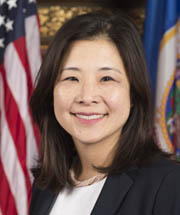Lessons from the Children’s Water Festival
October 2017
It’s a beautiful sunny September day. About 20 fourth-graders are clustered around a large table-top covered in sand, modeled to look like a stream bed. As Jack Barland and Dan Henley from the Council’s Environmental Services staff pour water onto the table, the kids can see how it flows across the landscape. Even better, from the perspective of a 10-year-old, they can dig in the wet sand. This messy fun teaches children an important lesson about how decisions we make upstream can impact others.
 The Met Council has been involved in the Children’s Water Festival since it first began 20 years ago, and I was thrilled to join in the fun this year. Organizers expanded the event to allow 1,600 fourth-graders from schools across the seven-county metro area to participate. The event is so popular that the participating classrooms are chosen by lottery.
The Met Council has been involved in the Children’s Water Festival since it first began 20 years ago, and I was thrilled to join in the fun this year. Organizers expanded the event to allow 1,600 fourth-graders from schools across the seven-county metro area to participate. The event is so popular that the participating classrooms are chosen by lottery.
The first children to attend the water festival are now old enough to send their own kids to the event. To me, that is a cogent reminder that decisions we make about water will impact our region for generations to come.
I am proud of the partnerships we have built with communities to keep water clean with one of the finest wastewater treatment systems in the nation. We also partner with communities to help them plan for their long-term water supply needs. Even in the land of 10,000 lakes water can be a finite resource.
People in this state are passionate about water. We heard from hundreds of residents at the Governor’s “25 by 25” Town Hall meetings. Gov. Dayton has challenged the state to improve water quality 25 percent by 2025. To get there, he’s been gathering input from people across the state.
Our region faces difficult challenges. In the urban parts of the metro area, aging wastewater infrastructure is allowing clear water into the wastewater treatment system. In excess, this groundwater and stormwater can cause sewer backups and overflows, a threat to public health and the environment. It also threatens the region’s economic health by taking up space in the wastewater system needed for future growth. The Council and communities are making good progress to address this issue, but there is more work to be done. In some rural parts of the metro, high levels of nitrates linked to agricultural fertilizers are showing up in wells for drinking water. The solutions are not easy or inexpensive.
While the young people at the Children’s Waster Festival are learning about runoff and water tables from us, they are reminding us that clean and abundant water resources should be their birthright. It’s the job of everyone to build partnerships that produce real solutions, so the next generation inherits water resources better than those we inherited from our parents and grandparents.
Alene Tchourumoff
See photos from the Children's Water Festival.
Tags: 25x25, festival, groundwater, quality, stormwater, wastewater, water